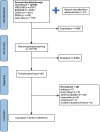The effectiveness of rehabilitation interventions including outdoor mobility on older adults' physical activity, endurance, outdoor mobility and falls-related self-efficacy: systematic review and meta-analysis
- PMID: 35737601
- PMCID: PMC9220027
- DOI: 10.1093/ageing/afac120
The effectiveness of rehabilitation interventions including outdoor mobility on older adults' physical activity, endurance, outdoor mobility and falls-related self-efficacy: systematic review and meta-analysis
Abstract
Objective: To determine the effectiveness of community-based rehabilitation interventions which incorporate outdoor mobility on physical activity, endurance, outdoor mobility and falls-related self-efficacy in older adults.
Design: MEDLINE, Embase, CINAHL, PEDro and OpenGrey were searched systematically from inception to June 2021 for randomised controlled trials (RCTs) of community-based rehabilitation incorporating outdoor mobility on physical activity, endurance, outdoor mobility and/or falls-related self-efficacy in older adults. Duplicate screening, selection, extraction and appraisal were completed. Results were reported descriptively and with random-effects meta-analyses stratified by population (proactive [community-dwelling], reactive [illness/injury]).
Results: A total of 29 RCTs with 7,076 participants were identified (66% high bias for at least one domain). The outdoor mobility component was predominantly a walking programme with behaviour change. Rehabilitation for reactive populations increased physical activity (seven RCTs, 587 participants. Hedge's g 1.32, 95% CI: 0.31, 2.32), endurance (four RCTs, 392 participants. Hedges g 0.24; 95% CI: 0.04, 0.44) and outdoor mobility (two RCTs with 663 participants. Go out as much as wanted, likelihood of a journey) at intervention end versus usual care. Where reported, effects were preserved at follow-up. One RCT indicated a benefit of rehabilitation for proactive populations on moderate-to-vigorous activity and outdoor mobility. No effect was noted for falls-related self-efficacy, or other outcomes following rehabilitation for proactive populations.
Conclusion: Reactive rehabilitation for older adults may include walking programmes with behaviour change techniques. Future research should address the potential benefit of a walking programme for proactive populations and address mobility-related anxiety as a barrier to outdoor mobility for both proactive and reactive populations.
Keywords: older people; outdoor mobility; physical activity; rehabilitation; social; systematic review; walking.
© The Author(s) 2022. Published by Oxford University Press on behalf of the British Geriatrics Society. All rights reserved. For permissions, please email: journals.permissions@oup.com.
References
-
- Tuna HD, et al. Effect of age and physical activity level on functional fitness in older adults. European Review of Aging and Physical Activity 2009; 6: 99–106.
-
- Mollenkopf H, Marcellini F, Ruoppila I, Flaschenträger P, Gagliardi C, Spazzafumo L. Outdoor mobility and social relationships of elderly people. Arch Gerontol Geriatr 1997; 24: 295–310. - PubMed
-
- Jacobs JM, Cohen A, Hammerman-Rozenberg R, Azoulay D, Maaravi Y, Stessman J. Going outdoors daily predicts long-term functional and health benefits among ambulatory older people. J Aging Health 2008; 20: 259–72. - PubMed
-
- Inoue K, Shona T, Matsumoto M. Absence of outdoor activity and mortality risk in older adults living at home. J Aging Phys Act 2006; 14: 203–11. - PubMed


